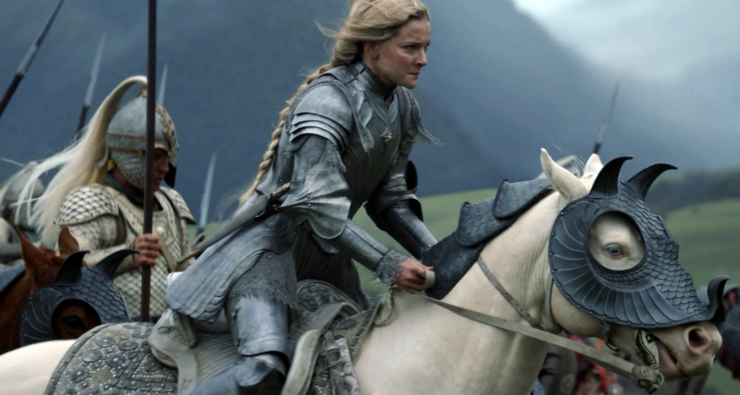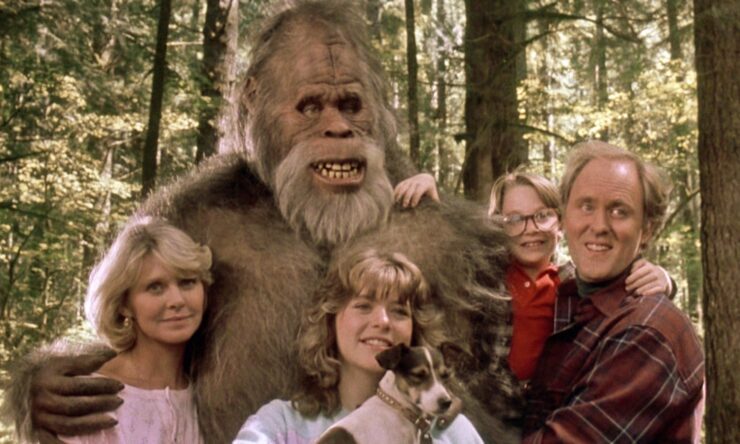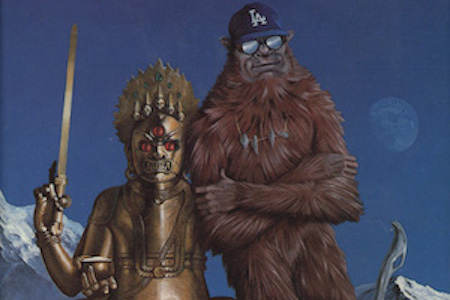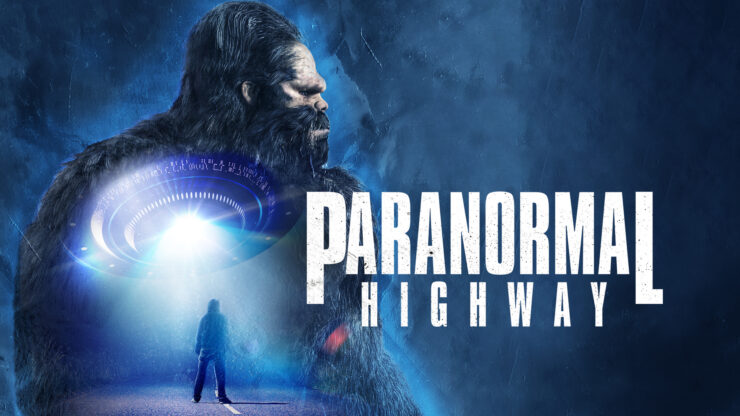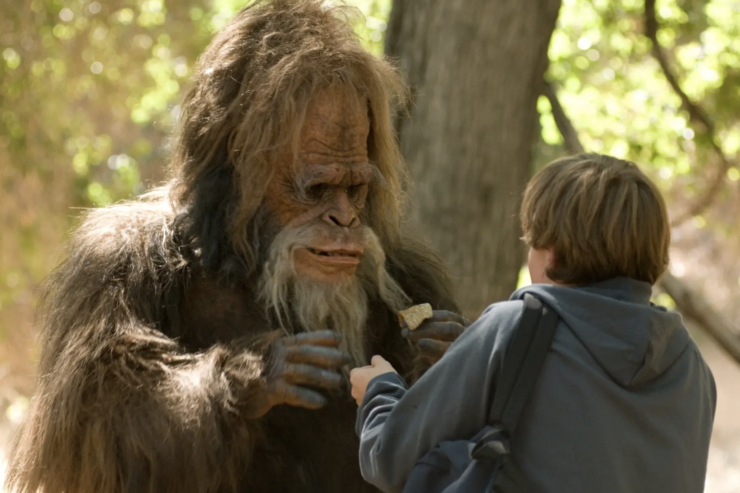Finding sources and scholarship on Tolkien’s Elf-Horses is surprisingly not easy. There’s ample discussion of the horses of Rohan, and with the first season of Rings of Power in the can, the horses of Númenor are getting some time in the sun. But Elf-horses haven’t had nearly as much attention.
That’s a little surprising because in The Lord of the Rings, after a nice cast of ponies including Sam’s beloved Bill and Tom Bombadil’s Fatty Lumpkin, the first named equine we see is Glorfindel’s Asfaloth.
Asfaloth is a white horse, in contrast to the nameless black horses of the Black Riders. He seems to share his rider’s propensity for casting light in dark places. He’s lightning fast and very smooth; even seriously wounded and half into wraithdom, Frodo is able to cling to his saddle until he’s been carried safely away from his pursuers. He also seems to understand Elvish: when Glorfindel cries out to him to Giddyap! Go Faster! (Noro lim! Noro lim, Asfaloth!), he obediently does.
Once he’s done his job of saving Frodo, he vanishes from the books. The rest of the horses we’ll meet consist of the horses of Rohan, including the Mearas, and various and sundry cavalry mounts, plus Aragorn’s own horse from the North, Roheryn. Roheryn, like his rider, looks rough but has great courage and endurance.
So who is Asfaloth and where does he come from? Is he a special breed unique to the Elves, or is he a mortal horse who happens to belong to Glorfindel and who has been imbued with some of his powers? For that matter, is he related to the Mearas? They’re the Númenoreans of horsekind, being longer-lived than ordinary horses, with unusual intelligence and enhanced physical attributes.
I am not a loremaster and have not read much past the basics—The Hobbit, LOTR, The Silmarillion—so I always welcome input from those more scholarly. The one thing I am sure of is that for Tolkien, horses mattered. They were integral to his world. Some of them had names and personalities and histories. They were important.
Therefore it doesn’t surprise me that a dive into various wiki-sources gave me the name of a horse of the Valar: Nahar, whom Oromë the Huntsman rode far back in the Elder Days. Horses existed all the way to the beginning, then. We don’t know where Nahar came from or whether he was immortal, but I’m going to speculate that he probably was.
If the Valar had horses, it makes sense to me that Elf-horses would have been descended from these. Then possibly there’s an Elros-and-Elrond situation that results in the Mearas. Elf-horses mating with mortal horses? Half-Elven offspring running in wild herds where the proto-Rohirrim come across them?
That might explain Eorl the Young’s horse Felaróf, and eventually Shadowfax. They are supposedly descended from the horse of Oromë, or from that line.
One comment on last week’s article made my fangirl’s heart leap with glee. Commenter ED observed: “As Eorl the Young & his riders skirted Lothlorien on their way to the Field of Celebrant the horses of the Eotheod appear to have received some sort of boost.” Considering the power of Galadriel’s ring and the general Elvish effect on all good beasts, that’s not surprising. I found a little more detail here:
In 2510, Eorl the Young led his Riders past Lothlorien on the way to the Battle of the Field of Celebrant. A white mist emanated from the forest to hide the Riders from the Shadow in Dol Guldur.
That’s a protective barrier for the whole army rather than an enhancement to the horses’ speed or strength, but I like ED’s version. Especially since my head canon has been greatly assisted by the horsegirl elements of The Rings of Power. I was pleased to be corrected on a particular point by commenter Tar-Elenion, who pointed out that while Númenoreans did not use cavalry in war, they were indeed horse breeders and they valued their horses highly. Isildur’s deep bond with Berek is right there in canon, in the Unfinished Tales.
So are those horses of the Valar or by extension Elf-horses? Considering how many gifts the Valar gave to the Edain who settled on the island, that wouldn’t surprise me. It’s very Tolkienian for an island kingdom to be supplied with horses of exceptional intelligence and a tropism toward bonding with humans, and for them to be the main mode of transport within the kingdom.
Buy the Book
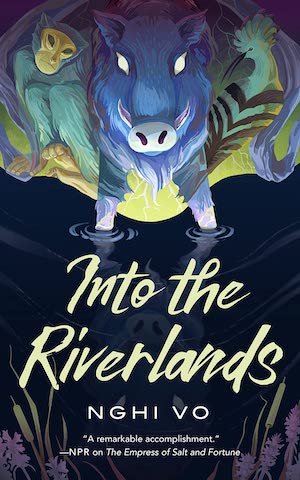

Into the Riverlands
It’s also very European. Real-world horse breeds of the continent, especially the horses of Iberia and their cousins and descendants, have traits very much like this. They live long, have exceptional endurance as well as beauty and grace, and understand the speech of Men.
Which brings me to Galadriel’s horse in the series. When I first saw the teasers, I thought it had to be an Elf-horse. Galadriel is riding him, after all, and his coloring is so unusual and his beauty so extreme. He must have come from one of the herds of the Elves.
I was surprised when the series aired, that he apparently is a horse of Númenor, possibly from the royal stables. Or else he belongs to Elendil’s family, though their other horses are much more traditional in their coloring: Elendil’s black Friesian (you can always spot those; they’re the ones with flowing leg feathers) or Isildur’s bay Berek. When the Impossible Cavalry thunder across the fields of Middle-Earth, they’re a pretty traditional mix of colors including Miriel’s lovely grey. But then there’s Galadriel’s blue-eyed pale-pink horse.
I’m waiting to learn more about him. So far we’ve been told that his name is Titan. He’s the best horse in the whole herd, according to Morfydd Clark, and she adores him. She rides him whenever she possibly can. Riding him, she says, is an incredible experience.
That sounds an awful lot like what we know of Elf-horses. Titan is a very unusual color, what’s known as a double-dilute cream. Hence the not quite white coat and the blue eyes. He also happens to be an exceptionally well put together animal (which is not always the case with horses bred for color), and it’s clear he has temperament to match. I’m happy to incorporate him into my head-canon as an exemplar of the Elf-horse.
As long as I’m in my head creating canon, I can see Galadriel being taken to the stables. Elendil has his own horse, of course. But there’s the one down the aisle, the pale head over the stall door, turning to watch her. Since he’s a horse of Númenor and therefore wiser than most (and horses are extremely wise), he knows what she is. He can see how she appears on the Other Side.
That’s when the click happens. Horse people know it well. Horse and rider meet, and know: they’re a match. Since this is Númenor and horses are accustomed to bonding with their humans, this horse knows what’s happening.
I’m sure Galadriel does, too. One of the other named horses in canon is Rochallor, the horse of her uncle the High King Fingolfin. Maybe she’s always wanted a horse who loved her as much as Rochallor loved her uncle. Maybe this is the one. Since it’s head-canon, I like to believe it is.
Judith Tarr is a lifelong horse person. She supports her habit by writing works of fantasy and science fiction as well as historical novels, many of which have been published as ebooks. She’s written a primer for writers who want to write about horses: Writing Horses: The Fine Art of Getting It Right. She lives near Tucson, Arizona with a herd of Lipizzans, a clowder of cats, and a blue-eyed dog.










